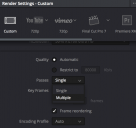
-
Sony cameras
Panasonic consumer camcorder manual part
Soft Skin Mode
When this function detects skin tones, it softens the focus in that area. This has a skin beautifying effect, which makes wrinkles and lines appear less noticeable. When turned on, this function makes blemishes and moles look less conspicuous, while preserving resolution in areas of the picture outside of the skin.
In stills skin smoothing is present also in around 90% of cameras, if not more. Sometimes via creative mode that turn it on, sometimes as special menu switch.
-
I was referring to the general skin smoothing functions in many TV cameras, called "skin-tone detail function" by Panasonic, for example. Or here is advice among Sony users for "skin detail" under professional conditions:
http://cinematography.net/edited-pages/F-900%20skin%20detail%20adjustment%20advice.htmYou are right, there are no face smoothing filters in those yet, but that may come, given the increasing number of AFs with face recognition. It seems to exist already in the A6000, given this discussion (and a few others):
https://www.dpreview.com/forums/thread/3933509
(I don't own one, so can't check that) -
I think you will find that there are no face smoothing filters in cameras. Where did you get that idea from?
-
Refining Filters
If the make-up department doesn’t get things right, every TV camera has some kind of skin smoothing these days. Sometimes it seems even our TVs add some more of it, looking at all those plastic ‚beauties‘ in soaps or news. While I’d normally switch that crap off, DR now has a Face Refinement feature that can do quite a bit better. It saves you from boring rotoscoping (if there are similar colors in the frame) by face recognition with automatic masking and identification of main features. Please note, though, that the points displayed for the features in the overlay are not editable, even if they look like it. So, you need to get the face tracking right by adjusting the parameters or enhance the features with a grading node in front of it.
Consequently, you may then fine-tune the smoothing or protect areas like forehead, cheeks or chin. The eyes get a lot of attention with local sharpening, re-lighting, highlights or virtual reduction of eye-bags. Maybe you want to blush the cheeks a bit or even change the color of a lipstick? The main challenge is getting the right balance between smoothing and detail. If you want the face of a villain to be a bit rougher, it can be done too.
My advice: if you get some time for applying and tuning this filter in post, it does substantially better than the features in cameras mentioned above, so tell the DoP not to use those. BTW, the mask it generates can be used as an input for another node if you simply need to make a face unrecognizable, like in docs.
While it was difficult in early betas, the function can track a face at an angle much better now (yes, I know, a lot of reflections on that chart, and too much compression):
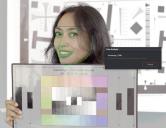
 Face_seitlich.jpg1600 x 1233 - 170K
Face_seitlich.jpg1600 x 1233 - 170K -
Compositing
While DR 14 will not replace or integrate Fusion, it’s own compositing features have been extended. A minor improvement is definition of another image source directly inside of the Color page. It’s still called a Matte, but actually can be anything. It became simpler in the Media Pool too, you can now just click Add as Matte for Color Page Clip. Alpha channels will not only pass through from the source, but any key you generate inside of Resolve will be combined and passed through as well. You can hand it over to other programs with ProRes 4444, but unfortunately there is no proper single file format on the PC for this, since DNxHR 444 doesn't work as promised until now. So, for the time being you’ll need image sequences like TIFF or use uncompressed ARGB (but that's 8 bit only). A helpful effect for keying is the new Alpha Matte Shrink and Grow.
Apart from the improved planar tracker, which now can be used as an anchor for many effects, there is the new Match Move tracker. This looks a lot like a conventional point tracker, but it can be used with a minimum of three small tracking areas to define a plane in your scene. In many cases it will recognize automatically if a track is lost due to foreground objects and deactivate that track. When the object is showing up again, it helps you to validate the area if you're just moving the pointer there. It’s also quite easy to combine several trackers for a scene if there are frequent occlusions or tracked areas leave the frame. While Tracking and Positioning already work quite well in the current beta, the image is not yet showing up when I switch to Compositing. Funny detail: if you want to clear one part of a track, it says „Clear Past“ or „Clear Future“ to make it very obvious what you are going to delete. So philosophical ;-)
Together with the rotoscoping option of the older planar tracker you can solve quite a few tasks which you would have done with a full blown compositing software before. For example: you could insert a separate image source to be treated like a plane inside of your scene and add a copy of the scene to a second track. Now you’d mask out foreground objects meant to occlude that inserted image. The result would show your new image integrated with the scene in correct perspective and following camera movements. Foreground objects would cover it for full credibility. The regular tracker has been improved too, but primarily for stabilization, which comes close to Adobe’s Warp Stabilizer now and is even faster (the old Stabilizer is still there if you need the keyframes for copy-n-paste). The only feature still missing in this context is a rolling shutter compensation (always difficult in post). Anyway, DR's was already a good planar tracker for rotoscoping windows before, second only to Mocha from my experience.
BTW, there’s an anti-tripod filter too, called Camera Shake ;-)
The tracker is impressive, sometimes more reliable than Mocha, but the image to be inserted is not yet showing up:

 match Move.jpg1650 x 924 - 256K
match Move.jpg1650 x 924 - 256K -
Repair Department
Finally we get a Dead Pixel Fixer without buying from third-party, which not only does a pretty good job for that purpose but can sometimes also fix dust on the sensor or water droplets on the lens, depending on the scene. Time-lapse Deflicker and Color Stabilizer fix fluctuations caused by changing light, but they need good comprehension and careful adjustment of the parameters to avoid artifacts. Deband can reduce banding problems caused by limited bit depth (like Slog shot in 8 bit only) or introduced by too much compression (to some degree).
Dehaze is a kind of automatic grading for landscape shots (urban or nature) with excessive dust or haze in the distance. It tries to analyze the color and intensity of the haze to generate a kind of distance map from the foreground all the way to the sky. On this base it intensifies contrast and colors without loosing the character of the scene. Of course you could do all this by hand with a few nodes, but it saves time and does a decent job. Seems to work quite well with landscapes for intensifying log pictures too – after all, some people call the smog in Beijing „B-log“…
Lens Distortion is not only helpful when simulating these, but can also fix them as long as they are not the wavy „moustache“ distortion of some wide angle lenses (don't have a good test shot around, but it might be doing even that with two nodes). Since you can split the effect into color channels it will also fix CA, even for de-centered lenses if needed.
Mentioning distortions (even if it's not really repair): there’s now a Warp filter too. Like many filters in DR 14 it can be attached to the tracker's FX function, so it’ll follow the feature to be deformed. It is point-based (no tedious mesh adjustment) and you can specify any number of distortion points plus stop points where you want to limit their influence. This will not fully replace specialized plug-ins like RE:Flex, but that one alone costs more than the studio version of DR and is limited to Adobe After Effects.
-
New Features
BM extended the range of FX plug-ins coming with the software and they are sorted and easier to apply now, not only to nodes in the color page, but you can just drag-n-drop them on clips in the timeline. They broke some third-party OFX plug-ins in the beta, though. Some of the most interesting ones from BM come with the studio version only. But, as mentioned before, it’s price went down to 299,- and the final retail version won’t need a dongle any more (studio betas still need it). I won’t write about every single effect right now, just the most interesting ones.
The styling department offers Abstraction and Watercolor for a cartoonish look of your footage. This is not easy to do, since camera video always contains quite a few fluctuations in pixel values and the results could look quite nervous, but BM did not a bad job here when compared to tools like ToonIt. Of course they need a source with strong colors and contrast, clear forms and not too much detail. With the long list of parameters in Abstraction you can easily adjust filling and edges to taste, only the color of edges can’t be changed. Watercolor has fewer parameters to adjust and generally a softer look. The filter for shrinking or growing masks can also be used for stylization of smaller details (much like a min/max filter). Of course you can influence the outcome of all these massively by using a grading node before them.
Color Palette is helpful for graphic artists who need to know the dominant colors in a scene for title design or illustration. It analyzes a clip for it’s dominant colors and shows them in small swatches in the lower area of the frame. Just export a still and make the graphics department happy.

 Abstraction.jpg704 x 1074 - 184K
Abstraction.jpg704 x 1074 - 184K
 Flower_abstraction.jpg1920 x 1080 - 226K
Flower_abstraction.jpg1920 x 1080 - 226K -
Well, since H.264 rendering is not the greatest and fastest in DR anyway, you can always output a master/archival version and compress to a distribution codec with another tool. There is a lengthy discussion of the subject here:
https://forum.blackmagicdesign.com/viewtopic.php?f=21&t=56789I'll have a closer look at the multi-track performance soon.
BTW, now that Fusion 9 has Apple-certified ProRes output on Windows, there's hope for DR too.
-
..also ofx plugins (even one plugin ) slow down frame rate playback by 2-3 times fold (even when no other nodes added )
Any plugins?
It can be very inefficient implementation, like constant copy between GPU-RAM (as it is 32bit values for each of RGB).
-
Sounds like a bug.
-
I'm new to davinci as of 6 months ago . For me it's very smooth ,I'm on 14 studio beta version , pro res 4k from ursa is very smooth ,red raw is very smooth ,4k pro res from recorder is smooth .. the issue that needs to be resolved ,is if I have over 2 track on top of one another (and even when they are deactivated) playback starts to get cut off and slowed down ,once only one track is on timeline (in one space) everything is fine
-
Yes, FCP-X is really making good use of the available hardware.
Most strange here is that ProRes really does not need much hardware. So, it is interesting what can cause such big difference.
-
Tried using 14 Beta to edit a music video shot on Atomos Ninja Assasin 4k ProRes..... playback is awful for sync editing. Anything more than a single track needs rendering to play with any kind of smooth motion... Tried every optimization I could find, and eventually gave up and went back to FCP X.... I was never so happy to see my old friend X as I was that day.
You're not ready yet Resolve... I'm not buying a super system just to edit with you.
-
New Formats
Resolve supports frame rates up to 120 fps now and you can re-conform to other speeds in full frame increments from 1 to 120. Resolutions up to 16,000 by 16,000 pixel are possible, but where will be the hardware for such an „Ultra 8K“ format in 120 fps? New codecs: Canon C200, Nikon RAW, DNxHR, Arri RAW in Open-Gate resolution and MP3 audio on all platforms, even AC-3 audio (both in MTS and Quicktime files) is finally supported on all systems. H.264 with high 10 profile is read on Windows too and became speedier with beta 6. Support of H.265 is still limited, but clips from a Samsung NX1 work (R.I.P.). All codecs where BM needs to pay licenses are only supported in the Studio version, for sure. In general quite a few more metadata are read. DR understands CLF-LUTs too now, which are becoming a kind of universal format as it seems. If you'd like to try it out: BM has added a day for night look and a Kodak 2383 emulation.
For output a few formats have been added which are offering alternatives to ProRes, in particular on PC: DNxHR HQX in 10- and 12-bit versions and the whole list of VP9 Codecs. Googles VP9 is a license-free alternative to HEVC and supports resolutions beyond 4K and the important variants of HDR. It’s not only an internet codec, since there are lossless variants up to YUV 422 in 12 bit. Encoding of H.264 offers multiple passes as an option and ticking „Network Optimization“ allows beginning to play the clip before encoding is completed. Export to ProTools has been improved, e.g. it will keep track names intact.
Unfortunately, no other movie codec than ProRes 4444 is carrying an alpha channel up to now. But they seem to be working on an integration of the alpha channel in DNxHR files, though it's not functional even in beta 6. Should become a viable alternative to ProRes for PC users (well you can always resort to numbered image sequences like TIFF or TGA). This is promising since DR now supports alpha channels quite well, not only from the incoming file, but you can add keys and masks from grading nodes too. Which leads us to the next subject: compositing.
Alpha export is there, but only for individual clips and not yet working in anything but ProRes 4444:
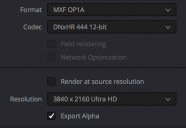
 Alpha_channel.png692 x 476 - 50K
Alpha_channel.png692 x 476 - 50K -
Speed
Lots of users have been criticizing the unsatisfying performance of DR, in particular with GOP-formats like H.264. The standard answer always was: this is a high-end software and it needs serious hardware. For everybody else the recommendation went: transcode into a format that’s easier to digest. But that solution needs time and storage space and for example Edius on the PC or Final Cut Pro X on the Mac cut through H.264 in 4K on a mid-level machine like butter and even Premiere was faster on decent hardware (unfortunately in most versions it also feels like beta, apart from taking your work hostage).
DR 14 now makes better use of the dedicated hardware built into most contemporary machines when decoding H.264 (and H.265 too) and finally you can edit native clips without a 12-core (where JKL still felt like wading through molasses). DR is snappier than Premiere now and comes close to FCP-X or Edius. Don’t expect miracles when grading, for large formats you’ll still need a GPU with enough VRAM and processing power. But it seems that a GPU with tight VRAM doesn’t crash DR so easily any more. On the Mac DR now supports Apple's new Metal GPU language, though I couldn't detect much of a speed boost from it (there's even a bug regarding VRAM value, see below).
BUT: until now they seem to try and force the studio version upon you, since the free version doesn't feel so snappy. I see it under Windows in particular, but the difference is there even on a Mac. I hope this is only a weakness of the beta versions. Otherwise: shame on you, BM, you don’t need such dirty tricks! With a new price point for the studio version of 299,- $ it’s worth what they are asking for with all the other features alone. So, please, don’t cripple the free version intentionally.
Of course, that notion of DR being 10 times faster now is just another case of marketing speak. A few routines might be really that much faster. But you don’t really expect DR to run as fast as before on a machine which is 10 times weaker, do you? After all, if you still want to transcode for other reasons (like editing on an average laptop), optimizing media is more than two times faster in version 14 and finally there is also a function to rediscover optimized media (which until now got lost regularly). The current betas feel quite a bit buggier on PCs than on a Mac. Now, after all, the possible variations in hardware and drivers are far more numerous under Windows and testing these is the main object of a public beta.
P.S. I didn't test multi-camera editing with more than 3 tracks in 1080 (don't have the media throughput right now anyway). Could be not that good with higher rez.
Strange report of missing VRAM on a laptop, but it works nevertheless:

 Metal.jpg1283 x 713 - 273K
Metal.jpg1283 x 713 - 273K -
Collaborative Workflow
Until now collaboration was limited to grading, while editors (or clients) could just have a look at somebody else’s timeline. This is going to change completely, all specialists can work in a team now (Studio version only!). You’ll obviously need a fast network for this and a common PostgreSQL server. It doesn’t need to be a dedicated machine, but should be up and running all the time for sure. The old multi-user scheme with individual login has been dropped for this. Of course any system needs some kind of locking mechanism not to create total chaos when working in a team, but DR is doing it in a quite simple manner. For editing you have bin locking, i.e. as soon as someone becomes the owner of a bin, all the included clips and timelines are locked against changes by others. They can look at the stuff and copy it into their own bins, though (copying means making links to the footage, not wasting space).
Now the new owner can make an alternative version of the edit and later both can compare their timelines with a pretty intuitive graphical tool. That tool, BTW, is available to you even if you are one person shop without a server and sit down next to somebody else to compare versions of the edit. Every discrepancy is nicely marked in the a graphical interface and you can accept or deny every single change. This method will apply to the Fairlight audio timelines too. Color grading is locking only the single clip while you are working at it. As soon as you activate another one, all changes become visible to others and can also be changed by them. Of course this needs a lot of discipline and trust in the team and some may ask BM for a bit tighter control of access rights – hey, in capitalism everybody is your competitor ;-)
OTOH there is an integrated chat system for teamwork and forming an organization…
Collaboration has logical consequences for saving: DR is now live-saving every single step to the current project immediately and the former auto-save by timed intervals has been dropped. The new approach allows for an undo history, one shared by Edit and Fairlight, another one for Color. But of course it’s also more risky, any serious hiccup can ruin your file and worst case make it unreadable. So, you should manually save versions frequently, in particular as long as you are testing the beta builds.
This is the graphical interface to compare timelines:
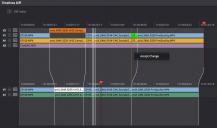
 Timelines_Compare.jpg1930 x 1137 - 582K
Timelines_Compare.jpg1930 x 1137 - 582K -
Fairlight Digital Audio Workstation
The biggest innovation in 14 is sound. Only about half a year ago BM bought Fairlight, a company with quite a name among musicians and video artists alike. They were based in „down under“ too, in Sydney, and they were pioneers in processor based audio recording, mixing and processing. From around 1981 musicians like Peter Gabriel, Kate Bush or Jean Michel Jarre have been producing with the Fairlight CMI sampler. What folks liked about them: even the latest versions of the software could still be operated with the old mixing consoles from decades ago, which may have been quite some investment at the time. Just like you can still run the Linux version of Resolve with a 15 years old, pretty expensive control panel. OTOH, Avid forced their customers into buying the new S3 or S6 control surfaces from version 10 of ProTools…
Well, fully integrating Fairlight with Resolve sounds (pun intended) very promising. Having a full blown DAW right inside your editing and grading system could beat Avid and ProTools, which are still not really integrated after all those years. But it’s obviously not so easy to do, the whole sound department in the current public betas is still the buggiest area in versions up to 6. At least they gave us three long awaited features right inside of the editing timeline:
– You can choose pitch correction for off-speed audio now
– You can edit audio at sub-frame precision by temporarily unlinking the tracks
– You can finally (well, it is still a bit unfinished in beta) record right into an audio trackApart from this, I’d rather allow them some more time to get things straight here, even if there is a lot to write about under the new Fairlight tab. Regarding Fairlight hardware for allowing more tracks (they mention hundred of them) or audio consoles for manual control, BM didn’t publish any plans yet. Neither pricing, though I'd expect both for IBC. But if you are one of those poor cutters who already had to learn color grading and are afraid now that you may need to become the audio guy or gal too, relax: humans are much stronger when collaborating and DR 14 is also about collaboration. See you tomorrow!
To illustrate pitch correction and sub-frame editing:
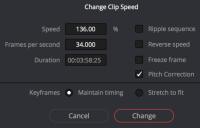
 Pitch_Correction.jpg775 x 496 - 132K
Pitch_Correction.jpg775 x 496 - 132K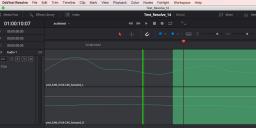
 Subframe_Editing.jpg2320 x 1099 - 180K
Subframe_Editing.jpg2320 x 1099 - 180K -
Thanks, Mike, for that tutorial. Apart from the missing levels before recording, I'd like to add two points:
– Would be great to have a visual countdown before the beginning of recording – Looping would be great too, automatically adding another track if you repeat
That's the way proper ADR is done ;-)
BTW, over the next few days I'll add some of my observations and thoughts about DR 14 here. Please forgive me if i touch subjects that have been covered before, this thread is already quite long…
-
No, you really have no idea. No need to tell me about my own experience or what I really want.
I have very good idea.
Look around - lot of robbers, murders, cheats and lot and lot of other stuff. And most of them have economic reasons. Same as your thoughts deep down. How cool it'll be to make this beginner wannabe to pay to reduce competition, sweet :-) But of course you bury such amoral thought deep down. No, of course you want for them to focus on hardcore colorists, of course.
Well that makes no sense at all. None of your statements in this topic are clearly thought out or articulated.
Absolutely. Poor old neurons in your head fight to keep their old connection even if it hurts whole organism, let them do their job. But as you'll eat more and read more, make another attempt, who knows that surprise can happen.
Howdy, Stranger!
It looks like you're new here. If you want to get involved, click one of these buttons!
Categories
- Topics List23,988
- Blog5,725
- General and News1,353
- Hacks and Patches1,152
- ↳ Top Settings33
- ↳ Beginners255
- ↳ Archives402
- ↳ Hacks News and Development56
- Cameras2,365
- ↳ Panasonic994
- ↳ Canon118
- ↳ Sony156
- ↳ Nikon96
- ↳ Pentax and Samsung70
- ↳ Olympus and Fujifilm100
- ↳ Compacts and Camcorders300
- ↳ Smartphones for video97
- ↳ Pro Video Cameras191
- ↳ BlackMagic and other raw cameras116
- Skill1,960
- ↳ Business and distribution66
- ↳ Preparation, scripts and legal38
- ↳ Art149
- ↳ Import, Convert, Exporting291
- ↳ Editors191
- ↳ Effects and stunts115
- ↳ Color grading197
- ↳ Sound and Music280
- ↳ Lighting96
- ↳ Software and storage tips266
- Gear5,420
- ↳ Filters, Adapters, Matte boxes344
- ↳ Lenses1,582
- ↳ Follow focus and gears93
- ↳ Sound499
- ↳ Lighting gear314
- ↳ Camera movement230
- ↳ Gimbals and copters302
- ↳ Rigs and related stuff273
- ↳ Power solutions83
- ↳ Monitors and viewfinders340
- ↳ Tripods and fluid heads139
- ↳ Storage286
- ↳ Computers and studio gear560
- ↳ VR and 3D248
- Showcase1,859
- Marketplace2,834
- Offtopic1,320



